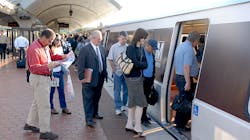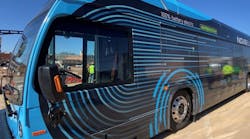WMATA Board approves $4.8 billion FY24 capital and operating budget
Washington Metropolitan Area Transit Authority (WMATA) Board of Directors approved the $4.8 billion capital and operating budget for fiscal year (FY) 2024 centered on supporting WMATA’s goal to provide the region with more reliable and frequent bus and rail service. The approved FY24 budget will also simplify fares, create a new low-income fare program, cap MetroAccess fares and enhance safety.
While a $185 million operating budget gap exists, WMATA plans to bridge this using a combination of increased revenues, expense reductions and utilizing federal funding provided in emergency relief funding, as well as formula funding through the Infrastructure Investment and Jobs Act.
“The FY 2024 budget focuses on optimizing Metro services while continuing to invest in long term infrastructure and sustainability projects,” said Metro General Manger and CEO Randy Clarke. “With this budget, we are proud to invest in more frequent rail and bus service and a better customer experience, maximizing the value we deliver to the region with available resources.”
The approved FY24 $2.4 billion capital budget includes building new bus garages to support a zero-emission bus fleet, the purchase of new Metrobuses and MetroAccess vehicles, advancing WMATA’s new 8000-series railcars , technology upgrades to support next generation train systems and development of Blue, Orange and Silver rail line corridor improvements.
Service improvements
The budget will deliver increased frequency within the central portion of WMATA’s network, which serves fast-growing areas with high ridership potential. The budget supports WMATA’s efforts to bring six-minute service to 75 percent of rail customer trips. Green, Yellow and Orange Line trains will see increased frequencies, with Green and Yellow trains operating every six minutes, and Orange Line trains will operate every 7.5 minutes during peak periods and every 10 minutes during off-peak. WMATA says the FY24 budget delivers the highest number of trains in its history on the Southern Green Line
The budget will also expand its high-frequency bus network to 21 lines. This expanded bus service will provide all-day service to half of WMATA’s bus customers. The agency says the result will be a more useful network with improved access to key destinations, including job centers.
Fare structure
The FY24 budget includes what WMATA calls fare optimization where Metrorail fares are simplified, ridership and revenue is expected to increase and WMATA’s most price sensitive customers will see transit become more affordable. One example is the capping of MetroAccess fares for the first time; they will not go above $4.
“This is a win for customers,” said WMATA Board member Sarah Kline. “We know MetroAccess serves our most vulnerable populations. To make this change for customers who use this service really does highlight our focus on equity across all Metro services.”
The Metrorail base fare in the FY24 budget matches bus fare and the mileage rate will be standardized. Longer-distance riders will not see Metrorail fares go above $6 on weekdays and $2 on late nights and weekends, which will eliminate weekday peak and off-peak fares.
WMATA also plans to implement a region-wide low fare program that offers customers enrolled in the Supplemental Nutrition Assistance Program (SNAP) a 50 percent discount on trips, which is similar to the discount provided with senior and disabled reduced fares.
The simplified fares and Metro’s first low-income fare programs are scheduled to take effect on or about July 1, 2023.
Safety
Safety is an element mentioned throughout both the operating and capital budgets and WMATA understands if it wants to continue to attract riders, they will need to feel safe while using the system. The budget includes hiring Crisis Intervention Specialists, providing training in mental health awareness and de-escalation method and implementing a Customer Experience Liaison outreach program to enhance staff visibility throughout the system.
One of the larger safety initiatives funded by the budget is the creation of the Metro Integrated Communications Center (MICC), which WMATA describes as a one-stop-shop to improve communication and coordination among operations. The MICC will consolidate WMATA’s rail, bus, police, video, maintenance, power and elevator and escalator operations into a single location working side-by-side in real time to enhance the customer experience throughout the system.
“This budget represents Metro’s continued commitment to provide safe, reliable, affordable and sustainable service by creating a more simplified and equitable fare system, optimizing the frequency of Metrobus and Metrorail services and increasing public safety throughout the transit system, and while this budget represents a big leap forward, Metro will continue looking for additional ways to be responsive to our customers’ and the region’s needs as the DMV continues to grow and evolve,” said WMATA Board Chair Paul C. Smedberg.

Mischa Wanek-Libman | Group Editorial Director
Mischa Wanek-Libman is director of communications with Transdev North America. She has more than 20 years of experience working in the transportation industry covering construction projects, engineering challenges, transit and rail operations and best practices.
Wanek-Libman has held top editorial positions at freight rail and public transportation business-to-business publications including as editor-in-chief and editorial director of Mass Transit from 2018-2024. She has been recognized for editorial excellence through her individual work, as well as for collaborative content.
She is an active member of the American Public Transportation Association's Marketing and Communications Committee and served 14 years as a Board Observer on the National Railroad Construction and Maintenance Association (NRC) Board of Directors.
She is a graduate of Drake University in Des Moines, Iowa, where she earned a Bachelor of Arts degree in Journalism and Mass Communication.




